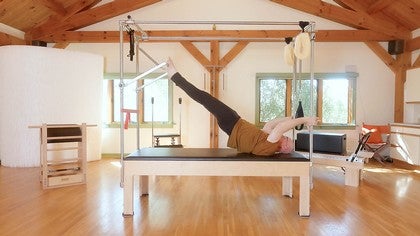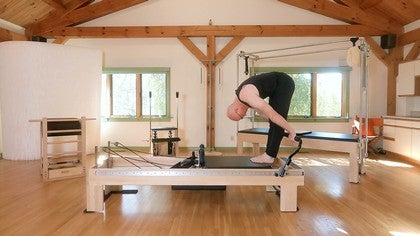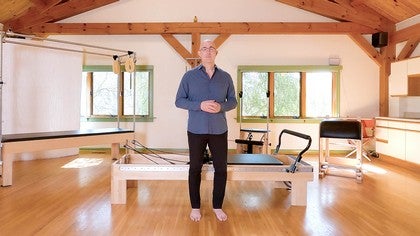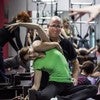Description
About This Video
Transcript
Read Full Transcript
Well, we finally have come to phase four, and this is the phase where I basically say we remove precautions and we basically should be participating fully in our daily activities and our work activities. Now, I say that with a disclaimer because every person is different and depending on the age, depending on their work, depending on their prior level of activity, everything can change. So as we say in PulStar it's always about the individual, not about the method, not about the sequence, it's always about the individual. So we modify these plans to be able to get there. At this stage of the game, we're looking at return to all daily activities, everything that they would do in their home that they would do in the community, being able to go shopping, being able to fly on a plane, being able to go up and down stairs, to ambulate a couple miles.
These are all things that should be part of their goals in this three to six month range. They also should be able to return to their work activities if they're working. So for example, if they have to be able to sit for a number of hours working at a desk they should be able to do that with some good instruction of sitting is the new smoking, another lecture for another day, that we don't want to sit too long. If they happen to be doing outside work or they're in construction or they're in education, that they should be able to participate in their work activities fully by this time. This is also the time that we start really looking at what recreational activities they want to participate in.
And we have to be thinking of how we guide that process. And at the end of these labs I'm going to come back and I'm going to give you some pointers on how to design a customized program for them to be turned to recreational activities. Right now, I want to jump right into the exercises with the reformer that are really exciting at this stage of the game. And again, remember, disclaimers, everybody, every individual different, and you'd want to know that they could do the previous exercises that we did in phase three, before you would move on or attempt phase four. You would also want to make sure that any types of comorbidities, what that means is do they have shoulder problems?
Do they have knee problems. Do they have stenosis? Have they had a previous stroke? Are there other health conditions that you need to take into consideration that really would make phase four irrelevant or not applicable to them? So very important that you're looking at the individual.
On the reformer I want to start with the knee stretch series and move right through down stretch and right through inverted V, long stretch, and up stretch series. So I'm not really going to stop. One of the things I love is sort of that transition of going from one movement to the next and sort of feeling that flow as if they're doing a full sequence and getting really ready to participate in a classical Pilates sequence without limitation, being able to maybe to return to some of their yoga practices if they had yoga practices, what would that look like? And so this is a great way to get them going. So join me.
I'm going to go with two red springs to start with knee stretch. And remember we started doing some knee stretch activities already in phase three where we just did the knees down and we did the hip with a flat back and we did the round back. So I'm not going to repeat those, but as we go into them now we can start thinking of something more advanced possibly where now the knees come off and they're working in knee stretch with knees off, down stretch, hips come forward, really is about shoulder exercise, keeping the body long. And again, integrating some of the mat work that we did and some of the thoracic extension the swan work ties into this as well as the swimming, getting just enough hip extension. And then from here coming up and you could slip in here like an elephant.
So an elephant would be nice. And give them that sensation now of starting to pull the carriage in. And then from here going up into our inverted V and plank Just simple inverted V and plank. And from here now, we can go into long stretch, again moving through the arms and we can also go into up stretch. So we come forward, we roll the body through as the carriage stays still, going back into the inverted V, pushing out into long stretch, coming through, rolling down.
And again, it's sort of that integration now of everything we've been working on in the previous phases. And I think you could have a lot of fun with that as you progress them through and really looking again for that transition, giving them something they could feel really proud about. Like, I was he able to do up stretch, that's a major accomplishment. And if they were our clients before and they were a dancer or a great mover what a great feeling to be able to do those kind of activities again. The next one I want to go into is jumping.
And I think this is the first time their feet are going to leave the standing surface that we've set for them. And this is another great way, and I'll start with something just simple like a red and a blue, giving them a sense of just disconnecting with the floor. And what we're looking for here is sort of that deceleration. So when we talk about deceleration and jumping, it's a toe, ball, heel, knee, hip, toe, ball, heel, knee hip. So I want you to sort of listen to that.
And what you'll often find with them is they won't know how to coordinate the ankle and the knee with the hip on the landing. It might sound sort of like a uh, and the whole carriage might move in the beginning. And this is a wonderful way of teaching them with little risk because the load's so light of how to start having that sequence, that if they were to jump off a step or they went hiking and jumped off a rope or they wanted to go dive off a diving board that they would know how to have that sequence again that was natural as a kid but they lost that when they started having the arthritis, and then of course, after the hip replacement. So coming onto the reformer. Again, I have a red and a blue spring down, I'm going to lift the head rest up.
I think it's nice for them to be able to see a little bit too what they're doing. And again, just simply warming up and maybe even going into up on the toes and sort of teaching the sequence of the landing. So they're going to come down toe, ball, hill, knee, hips. And then we start with just very simple, almost like a brush disconnecting from the machine. And then we can go into a little more aggressive jumps.
And here it's important to remember that the hang time could possibly be challenging for them. So in this stage of the game, we've removed the precaution or the contraindication of long lever against gravity. So we're able to do things like dead bugs and to have the leg up in air. So depending on their status, if they're feeling pretty good and we want to start getting the strength there but they're still feeling a little vulnerable, you can actually increase the spring, like add a yellow spring or a blue spring, and that sometimes will shorten the hang time and make it so there's less vulnerability to the hip flexors. Otherwise we can start working into more advanced work with things like beats.
We can work with brushing the leg off. And again, we have whole classes that use the jump board as part of the exercise class. So again, this is another wonderful way to get them to feel like, oh my gosh, I jumped today, even though our focus was really on the deceleration, toe, ball, heel, knee, hip, toe ball, heel, knee, hip, and really trying to get that quiet. And I'm just going to demonstrate for you what happens sometimes incorrectly is when they land and it's their first time they land with a straight leg and you'll hear it, you'll hear that boom, they hit really hard and the carriage might move and you know that they're not yet going into the deceleration that we've been working on actually in our assisted squats and our squat activities. So we're really listening for that nice toe, ball, heel, knee, hip quietness coming down, rather than a block with the leg being stiff.
And again, you can play a lot with many variations that they could enjoy. Now in phase three we did the seated knee extension and now we're going to advance that and take that into the gymnast. And then I'm going to go into reverse abdominals. I do this sometimes in my sequence in my reformer class. And then from the reverse abdominals I'm going to get the box back up and demonstrate climb a tree.
We've already done some basic box works. So we'll go up to that point. So starting on the foot bar, again, a red and a blue spring is appropriate. We basically tie in from the seated knee extension. And now basically I'm going to add the disconnect from the bar and tie it in with what we did on the chair.
So on the chair, we were doing the hamstring three. This is sort of a combination of the hamstring three and the seated knee extension. I'll do one more because I love this exercise because I can do this exercise. Then we come into the reverse kneeling, reverse quadruped and I'm going to go down a little bit on this spring. I'm going to take it down all the way to a blue spring at this stage of the game.
And this is now really going after hip flexors. So different from the hip extension on this one, I come within about three finger widths of the knee to the shoulder pads. I make a perfect square or as close as I can to it and then lean forward until thigh hits the shoulder pad, creating a parallelogram. And then from here just gently drawing the knees in, disassociating. And this is a beautiful way to sort of recreate some early hip flexion strength without overloading the hip flexors.
And again, a very light spring at that. From here if I want I can make it more advanced by simply bringing arms to one side, doing the same thing. And I can also remove a leg and go into a quadruped position or some kind of variation like that that continues to challenge them as they do these exercises. Lastly, we're going to go into some box work. We've already talked a lot about some of the basic box work that we were doing in short box.
And what we want to do here is show that we're ready to go into some more advanced work. So I want to demonstrate climb a tree that I think is a beautiful exercise. And it does load the front of that hip. So safety wise, I have all the springs on. I've set my box back for my height.
I have my safety strap. I'm going to make sure that I have the right height for me and the right distance. And from here, I can go into my more advanced work, going back further, doing more work there. And I can also now enjoy some choreography like climb a tree. And coming down.
And I would start just going to that horizontal place. We've already done some work with reaching their foot, bringing back up, bend the knee in, going back. And it's also sorta like the modified roll up using the leg to be able to pull ourselves up and to be able to start exploring that. And I probably would not, especially on the surgical leg, I would not go past the horizontal position if that's your stable leg that's holding onto the strap and just keep it to horizontal at this stage of the game. That concludes our new adventurous reformer exercises in phase four.
And next we're going to move into the chair and the mat and the trapeze table. So now that we have the trapeze table, we're going to do three exercises. The first one is going to be spread eagle. And this really is more of a fun exercise. It's not difficult, but it has this sense of doing something big and integrated, sort of ties into the breathing exercise or getting the parakeet, that going from the flexion to whole body extension and really appreciating that hip extension and thoracic extension.
And then from there, we're going to go into kneeling cat. And kneeling cat ties into the hamstring one, particularly if you were doing it in kneeling. So again, it's really learning how to get that thoracic mobility in flexion. And that takes a little bit of stress off of the hip and the low back with their flexion of doing things like getting dressed or putting their shoes on or other activities. And then the last one, one of my favorite all time exercises is what we do in PulStar called the dolphin.
So that is really a full integration of hip extension flexion, spine extension, bridging, feet in straps, put it all together and we create a motion that looks like dolphin. So I'm just going to go straight through these three exercises on here. I hope you'll join me and get your machine ready to go. So the first one is going to be the spread eagle, and spread Eagle, I like to sort of cock my toes back a little bit on the bar for safety purposes, and then I'm going to grab up on the bar and just coming into extension, back, and then come back down here. So it's just sort of this pulling through motion and then sitting back motion through the hips.
So they're really learning to have this motion here in particular of going to extension and now combining it with the extension that we learned in our swan and swimming and all of the other extension work that we've done. So sort of a fun one. The next one is going to be kneeling cat. So in this one I get up into a high kneeling position and I want to be able to keep my femurs vertical. That's the primary objective here.
And it's just like if I had my hand on the pedal of the chair, same idea is I'm rolling my spine through trying to keep my fingers vertical. The most common mistake is to drop the pelvis back. So they have to use a lot of sort of we call it the mula bandha around there to be able to go into that position and then disassociate and take it out into the extension and the reach of the cat, pulling it back up through the pubic bone, the rib cage, stacking the spine back on top of the vertical femurs. So we'll do that a couple of times. And I think here is sort of like the cat cow we sort of talk about in the mat work.
You get to push down into this bar and really lift up and articulate through the spine. And you're going to be back if you want to add some choreography to it. Last one. And reach. And again, when we did the quadruped, thinking of getting that nice hip articulation in there, spend some time in there and let them really feel that and appreciate that they now have that new range of motion that they had lost from prior to the surgery.
So that's the kneeling cat. Something to be careful of, just a precaution, whenever you're doing things like the spread eagle or things coming up, make sure that the crossbar is pushed all the way down so that you don't hit your head on the bar while doing the exercises. This last one on the trapeze table I mentioned is one of my favorite. and it's the dolphin. And it sort of ties in with what we've already done with the parakeet, except now you're not on a pseudo closed chain structure, like the foot bar, you're actually pretty free.
So we can start just with a little bit of a bounce and then coming up and articulating through. So now there's some choreography in here as we do this. And I'm using two purple springs to lift up my heavy legs. And I could also reverse it, which might look like the very first exercise we did of heel slides. But the hillsides now are going into a hip extension and up, and rolling through the spine.
And that concludes our work on the trapeze table. So we'll now move into the chair and the mat work. So now we're ready to move into the chair exercises in phase four. And I just have two exercises I want to show you. One is a variation of the lunge, which is the side lunge.
And then I also want to show you bowing which I think is a really challenging exercise for the deep hip muscles. And I'm telling you what I'm doing now ahead of time so that I don't run out of breath while I'm demonstrating them. They're actually nice and challenging for me at this stage I am right now with my hip, so let's get started. So one thing is, and we tell our students, is to always mount the normal straightforward way and then turn when you're up on top. So the leg that's on the pedal is going to go back, the leg in front turned out.
And you can use the handle to begin and get used to that motion. And then you can get rid of the assistance. And again, I'm really looking at that nice deep squat, being able to keep the alignment on the leg that is doing the work. And again, we start with a heavy spring and then work our way up into a lighter spring and also working coming all the way up onto the chair. So the next exercise is bowing.
And in bowing, you want to get yourself set into a pretty decent squat position, hands down to the side, start pumping the back leg, bringing the pelvis forward as you're pumping that back leg and then back down. So it's again bringing that chest up, pumping that back leg, and moving the body into position. So it really challenges the standing leg almost more than anything to be able to recruit those deep rotators and the butt muscles. So we are ready to move into the last part of phase four, which is our mat work, and I'm going to bring the Oov into it for a really cool standing series. And then we'll just talk a little bit about how we can convert some of these for home exercises.
I mentioned to you that at this stage in phase four we don't really have the precautions for an anterior hip replacement that we had in phase one, two, and three of avoiding anterior load to the hip. And so it makes sense at this stage of the game to go into things like our dead bug exercises. So there's no reason now that we can't be working on just simple dead bug. We can also go into a little more advanced variation where the legs stay up and we can go with a double leg dip and back up. We can add the arms to it, alternating.
And again, starting to work on the strength of the hip flexors. We can also work right into the hundreds, if we wanted to, here with bent knees, doing some variation loads and increasing load on that hip flexor and just introducing some long lever load. and then back, is a nice way to be able to start loading the anterior hip in these exercises. Also in here, we start working on some hip range of motion and that's going to be with the mermaid. Now, I don't expect people following a hip surgery to be able to go into mermaid right away, so we can use a box or a chair to assist and have them sit up on the box and we can explore sort of what their internal external rotation is at this stage of the game.
So are they able to get into the internal rotation up on a box and get their sit bones down for a mermaid or the external rotation on the other side and be able to get familiar again with some internal external rotation that they might have to be able to go into their mermaid? So for me, my limitation was internal rotation. So I have my right hip that had the hip replacement in internal rotation. And I'm going to continue to sort of build my ability to move into that hip. And then as I get more and more movement I can get rid of the box or I can get a towel or a blanket.
And now I'm able to work into the full range of motion. It didn't come overnight. It took me a couple months to be able to actually get the internal rotation to sit down on. And I still don't feel like it's the same as my left side but I have progressed to be able to do it as a mat exercise. So I'm pretty excited about that.
From here we can move into some strengthening of the side lift. And we can go right I'm just going to through a sequence of side lift to a more advanced version of the sidekick and sort of make that progression for us really focusing on getting the strength in the lateral hip. So coming down and now putting the legs out straight, we can start with a bent knee. There's a nice modification of just coming up into a side lift position, bringing the hip down and up, working the abductors of the hip. We can then go with the leg straighter and come up into a side lift and we can even test and see can they maintain that position that we do in the PulStar tests.
And then from here, we can go up into a more advanced variation and we can even try to do things like just a full side lift, maybe a sidekick, a star, all of those advanced exercises in a side lift position. It is challenging. Even a year or two post I still find it challenging, which it's probably challenging for most people, but there's no reason why we can't be challenging them at this level. I think that's the key point that I want to make for you is to take away the worry that they can't do a side lift exercise. The last thing I want to do is using the Oov is to introduce, oh, actually I got two more I want to show you that again are really great exercises.
And the first one is leg pull front. So I love going to leg pull front and I do it almost with every one of my Pilates mat classes if you've ever taken them on Pilates Anytime. But coming into the plank position and being able to again create the movement through hip extension. So great exercise. If you want to make it more challenging, you could do a trot, you could add shoulder slaps to be able to make that more challenging.
And then from there, a little ladybug just came down, we can go into our leg pull position, maybe starting with bent knees, lifting the pelvis up and back down. And up and then work our way to a leg pull. Again, long lever, hip flexion, hip extension on the opposite leg, core connection, and challenging the body now in that plank position, both prone and supine. Last thing I wanted to show you is with the Oov and this is going to be in standing. So one of the things we do in standing now is that we can stand on these uneven surfaces and buoyed around.
This is my affected leg coming down into my half squat, moving around, shifting side like I'm now getting ready to return to some activities like skiing, snowboarding, other activities could be skateboarding. You get the idea where they'd need to have that balance. So I just use any kind of prop that I can to be able to create that diversion of being on a stable ground. Love exercise. You can also approach it this way, where you're sort of side to side which you need a little prop to do it, to be able to hold on and get just like a wobble board side to side, more like skiing.
That concludes our mat exercises At home they obviously can do their dead bug exercises and progressions of those. And we talked about doing some single leg balance. Now you can challenge them a little bit more, like have them on top of a pillow or on top of a Bosu ball, or something that is unstable and starting to challenge their standing balance and standing exercises. Again, the more proprioception they have, the better. So don't feel bad about challenging that.
Sometimes I'll put them on an uneven surface and then have them bouncing a ball against the ground or against the wall or with a TheraBand pulling from a doorknob or wedged over the door. So there's lots of really cool ways to be challenging them in their home exercises. At this stage of the game, I mentioned with an anterior total hip there really aren't any precautions after six months. Again, if the doctor says, don't do this forever, then listen to that doctor and respect that order. If you're having a posterior hip replacement you will always have the flexion internal rotation adduction precaution with most surgeons.
So again, really be careful with that, understand what the doctor's orders are, make sure the patient understands their precautions. As I mentioned with my anterior hip replacement I was told that after three to six months I no longer had any precautions. And really the only precaution I had was just protect the anterior hip muscles and let them calm down for two, three months before we start going into hip flexion exercises. This concludes the four phases that we've talked about and also the pre-op exercise lab. I hope that they've been some ideas more than anything of sort of showing you at what level somebody should be at or could be at following a total hip replacement, using my story as the case in this one.
And again, reiterating the disclaimer that every person is different, every surgeon is different. We all have different precautions. Please listen to the individual and pay attention to other things like comorbidities that might prevent them from doing some of these activities. Even though their hip could handle the activity maybe their knee or their ankle or their heart can't. This is also the time in phase three to six that most people should be forgetting that they had a total hip replacement.
They should be thinking that they're just about their daily life doing their thing. And they're not worried about this history of having had a major surgery and an implant in their hip. So that concludes phase four. And I'll see you in just a minute to talk about how we move forward into the future and design programs based on their choice of participating.
Me and My New Hip: with Brent Anderson
Comments
You need to be a subscriber to post a comment.
Please Log In or Create an Account to start your free trial.












